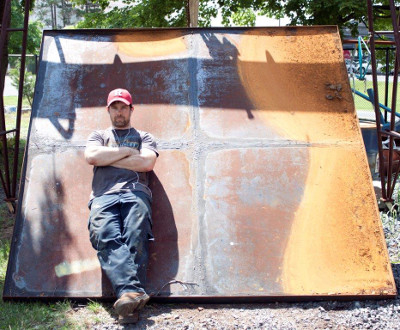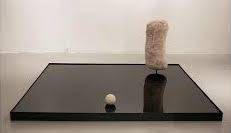‘Black Mirror’ Art Brings Rutgers Graduate Recognition, Grounds for Sculpture Spotlight
Motor oil-inspired piece blends working class and worldly concerns

'When you can take stuff and turn it into something that defies what it is, then it kind of holds a certain level of interest.'– Adam Murray
Before earning accolades for his sculpture work, 2013 Mason Gross graduate Adam Murray made his living by the brush – and the roller.
But after putting in nine years as a house painter, the art school dropout had grown weary of working with flat surfaces eight hours a day, six days a week. He longed for three dimensions.
“I wanted things that were going to take up space,” Murray said “I couldn’t look at flat areas any longer.”
The Wall Township native also was tired of relegating his pursuit of a professional art career to his off hours.
Though he had soaked up a good deal of informal training while volunteering at the Shore Institute of Contemporary Art, Murray knew if he was serious about becoming an artist, he needed to complete his BFA.
“I didn’t have the confidence because I didn’t have the degree,” he said.
So at 31 he enrolled in the Mason Gross School of the Arts at Rutgers, a bit tentative about how he’d mesh with his younger peers and pick up all the art terminology he’d missed after more than a decade away from school.
He left two years later a confident, accomplished artist and the recipient of International Sculpture Center’s 2013 Outstanding Student Achievement in Contemporary Sculpture Award. Murray and 11 others were selected from more than 400 students nominated from more than 159 colleges.
“Usually this award never goes to BFAs,” said Patrick Strzelec, an assistant professor of sculpture. “I’ve been teaching for long time, and every once in a while you’ll find someone who’s really special, someone with something different going on. Adam’s that kind of person.”
His winning sculpture, “Black Mirror,” will be on display at Grounds For Sculpture in Hamilton from October through March – making Murray the third Mason Gross student to have work displayed there in five years. His piece also will be featured in the 2013 October issue of Sculpture magazine and Grounds For Sculpture’s exhibition catalogue.
“Black mirror” was inspired by a Piscataway yard oddly adorned with a punching bag and garden gazing ball.
“It was one of those kitschy lawn situations. I barely saw it out of the corner of my eye. It forced me to turn around and look,” he said. “A punching bag from a tree is kind of silly, especially on your front yard on a major road. I thought, ‘Why not try to mess around with this.’ ”
Much like the yard, Murray’s piece juxtaposes his formal art training with his blue-collar roots and features materials more familiar to his mechanic father than most artists.
After carving up a tree felled by Sandy behind the Livingston Art Building, Murray applied a layer of Bondo – a body filler used for patching rust spots on vehicles – to give it the appearance of a punching bag. The gazing ball is a result of his “playing with plaster” and slathering it with a resin coating.
For the base, Murray wanted something seductive and reflective made from material not typically associated with beauty. Something that would make people stop and stare the way he did when he drove by that gaudy lawn.
To accomplish that, Murray filled an 8-foot-by-8-foot steel pan with 25 gallons of used motor oil – courtesy of his dad.
“When you can take stuff and turn it into something that defies what it is, then it kind of holds a certain level of interest,” he said.
The shimmery ebony surface seduced at least a dozen spectators into getting their hands dirty at the BFA opening, where his piece ended up being framed by black finger smudges.

While visually appealing, the oil’s pungent fumes also factored into the piece, said Strzelec, slightly stinging viewers’ eyes and nostrils.
“There are a lot of things going on in that piece. I thought it had worldly concerns. There’s a beautiful silence that occurs there, but there’s also this nauseating element that makes you uncomfortable,” he said. “All your senses are activated by it, which is kind of unusual for a sculpture.”
The piece hardly came together overnight, said Murray, who had incorporated both the punching bag and gazing ball in previous works before combining them in “Black Mirror” with more successful results.
That ability to tackle any assignment without fear of failure stems from the strict work ethic Murray developed as a laborer.
“You work all day long. You don’t take many breaks. The primary thing is you produce; you get things done,” said Murray, who tried to instill that ethic in his younger peers. “Whenever anyone had a problem or was stuck with thinking too much, I’d say, ‘Alright. Get to work and make something.’ ”
It’s that zeal to produce is indicative of a successful sculptor, said Strzelec.
“Pushing the idea of making is important. Adam is a maker,” Strzelec said. “Sculpture is 80 percent work and 20 percent creativity. You really have to get out there and work in order to make it happen, and he does it.”